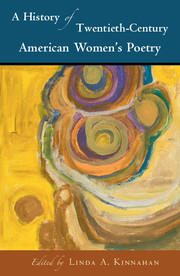Book contents
- Frontmatter
- Contents
- List of figures
- List of contributors
- Preface
- Acknowledgments
- PART I MAPPINGS AND CHRONOLOGIES
- PART II ETHNICITY, RACE, AND IDENTITY
- PART III MATERIAL FORMATIONS
- PART IV LINEAGES, TIES, AND CONNECTIONS
- 15 Token Women, Male Movements, and Literary History's Feminist Shadow
- 16 Lineages and Legacies: Real and Imagined
- 17 Crossing Geographies, Crossing Languages
- 18 Women's “spiritualities”
- PART V FORM, LANGUAGE, AND TEXT
- PART VI CODA
- Bibliography
- Index
18 - Women's “spiritualities”
from PART IV - LINEAGES, TIES, AND CONNECTIONS
Published online by Cambridge University Press: 05 June 2016
- Frontmatter
- Contents
- List of figures
- List of contributors
- Preface
- Acknowledgments
- PART I MAPPINGS AND CHRONOLOGIES
- PART II ETHNICITY, RACE, AND IDENTITY
- PART III MATERIAL FORMATIONS
- PART IV LINEAGES, TIES, AND CONNECTIONS
- 15 Token Women, Male Movements, and Literary History's Feminist Shadow
- 16 Lineages and Legacies: Real and Imagined
- 17 Crossing Geographies, Crossing Languages
- 18 Women's “spiritualities”
- PART V FORM, LANGUAGE, AND TEXT
- PART VI CODA
- Bibliography
- Index
Summary
Like the word “feminisms,” the possessed word in this chapter's title is necessarily plural, though our copy-editors may well be forced to take it out of both scare quotes and lower case where it belongs. Indeed, as our stylesheet suggests, they may do similar things to words that gesture toward “God” in what follows. But problems with, and scary distance from, language (and possession, too) are at the very heart of women's spiritual struggles over the course of the last century. As Fanny Howe put it in 1991,
“God” scares me, and that's a fact. It also scares me to imagine that I might be seduced by the tones, turns and musics of a poetic tongue which is arranged to create a false idol, an illusion…. Silence is the only effective and terminal antidote. Before that, it may be the case that the prose line is the least apt to succumb to falsehood. Much of my writing has been an effort to rearrange, rewrite the word “God” by filling up pages with other names. I don't like the word “God” because of its Roman weight. But when I write, I rewrite that name, and then what I write, if it is written well, becomes not a new “God” but a new person, a human face. If a face does not gaze back at me from the page, there is only paper and wood, the static object empty of divine spark. The human face in repose and silence is the face I see, when what I have written approximates the unspeakable.
This very clear, if complex, prose-poetic passage speaks volumes about the concerns and experimental strategies that have connected women poets reinvestigating inherited spiritual resources for what survives of them after modernism's seismic challenges on so many fronts – scientific, philosophical, psychoanalytic, anthropological, etc. – in addition to those posed by themselves: half the population overwritten by such resources for millennia but suddenly voluble, ready even to “rewrite that name,” the word for divinity.
- Type
- Chapter
- Information
- A History of Twentieth-Century American Women's Poetry , pp. 289 - 304Publisher: Cambridge University PressPrint publication year: 2016

